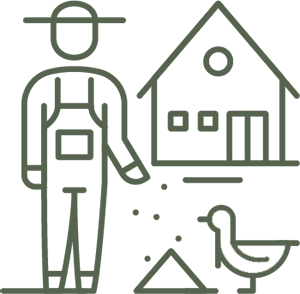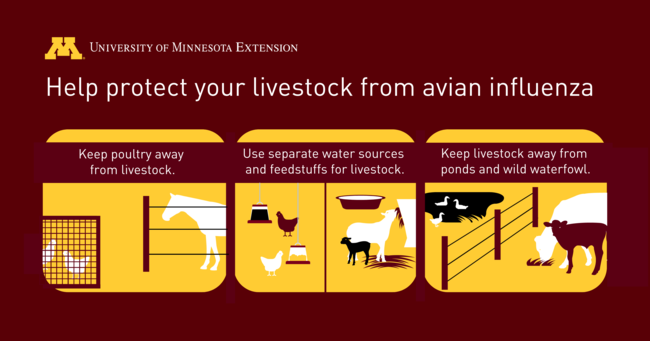UPDATED MARCH 2024

Highly Pathogenic Avian Influenza (HPAI), also known as “bird flu,” is a severe and highly contagious disease. Caused by avian influenza virus A (H5N1), it’s often spread by wild birds like ducks and geese during their migrations, especially during the spring and fall. When spread to domestic poultry, like chickens and turkeys, HPAI can be deadly and wipe out entire flocks in just a matter of days.
While HPAI primarily occurs in birds, poultry, and some mammals, for the first time in U.S history, there have been detections of HPAI A (H5N1) infections in dairy cows and goats.
-
Learn more about HPAI in dairy herds in this USDA Q and A, and how to protect your livestock from avian influenza and what cattle and beef producers can do to reduce livestock and avian interaction with resources from University of Minnesota Extension.
HUMAN INFECTION
Avian (bird) influenza (flu) A viruses, including A (H5N1), do not usually infect humans. However, there have been some rare cases of human infection with these viruses mainly through unprotected, direct physical contact or close exposure with sick or dead birds, and infected animals (including, recently, infected dairy cattle livestock).
According to CDC’s interim recommendations, people should:
 Avoid unprotected exposures to sick or dead animals including wild birds, poultry, other domesticated birds, and other wild or domesticated animals (including cattle), as well as with animal carcasses, raw milk, feces, litter, or materials contaminated by birds or other animals with confirmed or suspected HPAI A(H5N1)-virus infection.
Avoid unprotected exposures to sick or dead animals including wild birds, poultry, other domesticated birds, and other wild or domesticated animals (including cattle), as well as with animal carcasses, raw milk, feces, litter, or materials contaminated by birds or other animals with confirmed or suspected HPAI A(H5N1)-virus infection.- Refrain from preparing or eating uncooked or undercooked food or products, such as unpasteurized (raw) milk, or products made from raw milk such as cheeses, from animals with confirmed or suspected HPAI A(H5N1)-virus infection (avian influenza or bird flu).

“At this time, there continues to be no concern about the safety and availability of pasteurized milk products nationwide. Pasteurization has continually proven to inactivate bacteria and viruses, like influenza, in milk and is required for any milk entering interstate commerce.” – FDA
-
Read more about milk safety and supply during HPAI outbreaks.
Find more specific recommendations, like wearing proper PPE (personal protective equipment), for farmers; poultry, backyard flock, and livestock owners; and workers.




 Read more from UMASH Director and University of Minnesota School of Public Health Professor, Jeff Bender, DVM, as he answers key questions and provides insights about Highly Pathogenic Avian Influenza (HPAI) among wild birds and livestock, in these articles from published by the University of Minnesota School of Public Health and Center for Infectious Disease Research & Policy (CIDRAP).
Read more from UMASH Director and University of Minnesota School of Public Health Professor, Jeff Bender, DVM, as he answers key questions and provides insights about Highly Pathogenic Avian Influenza (HPAI) among wild birds and livestock, in these articles from published by the University of Minnesota School of Public Health and Center for Infectious Disease Research & Policy (CIDRAP).